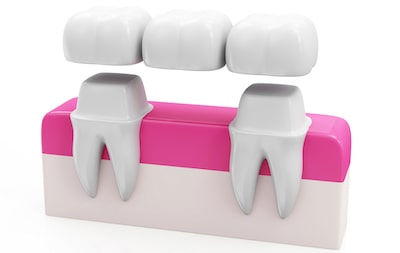A dental bridge can close, or bridge, the gaps in your smile if you have teeth that are missing. A dental bridge is a false tooth (and it is also called a pontic) that is held in place by the teeth on either side of the gap. These teeth on the sides of the gap are called abutment teeth. Unlike dentures, a bridge is usually a permanent solution that cannot easily be removed by the patient.
A dental bridge is a proven way to replace a missing tooth. It can also be used to hold your other teeth in place. A dental bridge can make your everyday activities easier. When a bridge is used with dental implants, the bridge can prevent bone loss and help preserve the natural bite structure and shape of your face.
 When you have a missing tooth or multiple missing teeth, it can impact you more deeply than just changing how your smile looks. Our teeth are made to work together. If a tooth is missing, nearby teeth can move into the empty space. A dental bridge can prevent that movement and address changes to the function and appearance of the teeth including:
When you have a missing tooth or multiple missing teeth, it can impact you more deeply than just changing how your smile looks. Our teeth are made to work together. If a tooth is missing, nearby teeth can move into the empty space. A dental bridge can prevent that movement and address changes to the function and appearance of the teeth including:
The four main types of dental bridges are:
The traditional dental bridge usually consists of a false tooth or teeth held in place by dental crowns. These crowns are cemented onto each of the abutment teeth. This type of bridge is the most popular type of dental bridge and can be used when you have natural teeth on both sides of the missing tooth or teeth.
Although this type of bridge is quite like a traditional bridge, the pontic in a cantilever dental bridge is held in place by a dental crown that is affixed to just one abutment tooth. For a successful cantilever bridge, you only need one natural tooth next to the missing tooth.
This type of bridge is also similar to a traditional bridge. A Maryland dental bridge employs two natural abutment teeth and they include one on each side of the missing tooth. However, while the traditional bridge uses dental crowns on the abutment teeth, a Maryland bridge uses a framework, usually constructed of either metal or porcelain, that is bonded onto the backs of the abutment teeth.
Implant-supported bridges use dental implants as opposed to either the aforementioned crowns or frameworks. Most of the time, one dental implant is surgically placed in the mouth for every missing tooth. These implants hold the bridge in position. If an implant for each missing tooth is not possible, the bridge may have a pontic suspended between two implant-supported crowns. The implant-supported bridge is the strongest and most stable system, but it is also a very time intensive procedure. An implant-supported bridge commonly requires two surgeries. The first surgery is to embed the implants in the jawbone and then a second surgery is performed to place the bridge.
The price of a dental bridge can vary widely depending on several factors:
The costs also depend on the type of bridge chosen:
Your bridge can last many years without suffering from any type of complications (if you care for your bridge properly). If the surrounding teeth suffers from decay, or if the cement deteriorates, the dental bridge may fail. However, If the bridge becomes loose and the supporting teeth are still healthy, your provider may be able to properly reattach it.
Some of the factors that could make you a good candidate for a dental bridge include:
If you think a dental bridge could be right for you, schedule a consultation appointment with your dentist for a thorough exam of your teeth and an in-depth discussion about the type of results you can expect before deciding whether a dental bridge is right for you.